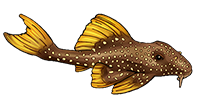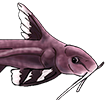https://www.mapress.com/zt/article/view ... a.5481.1.6
Abstract
The early development stages of (Boulenger) are described through morphological, meristic, and morphometric data, providing useful traits to identify its larvae and juveniles. Additionally, the growth pattern throughout the species’ development has been determined from the smallest specimen of 3.93 mm (flexion) to the largest of 25.77 mm (juvenile). Ninety-one specimens classified into two larval stages (flexion and postflexion) and five juveniles were analyzed. The individuals were collected between 2011 and 2019 at sampling stations distributed across the Amazon basin, in the water systems of the Japurá, Solimões, and Amazonas rivers. The larvae and juveniles are characterized by having small, spherical eye, terminal mouth, rounded snout, and a dorsoventrally flattened head with three pairs of barbels (two pairs of mental barbels and one pair of maxillary). The anus does not reach the midbody region, and the adipose fin has a triangular shape. The upper caudal-fin rays extend, forming long caudal filaments. Initial pigmentation is restricted to dendritic and punctiform chromatophores irregularly distributed on the dorsal region of the head, and from postflexion onwards, along the dorsal region of the body. The total number of myomeres varies from 58 to 59 (22 pre-anal and 36 to 37 post-anal). During early development, B. juruense exhibits predominantly isometric growth. Larvae and juveniles of B. juruense can be identified by the number of myomeres, external morphology including pigmentation, head shape, and morphometric proportions. This information is essential for the accurate identification of larvae and juveniles captured in their natural environment.





